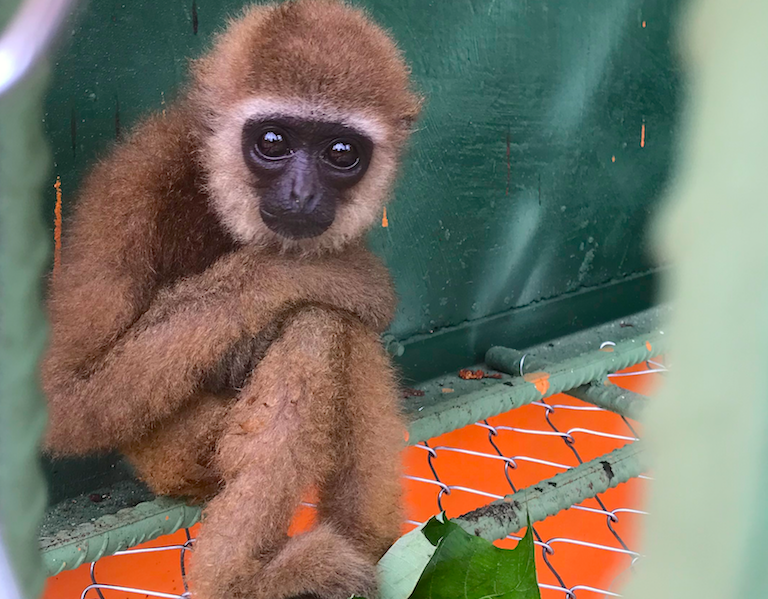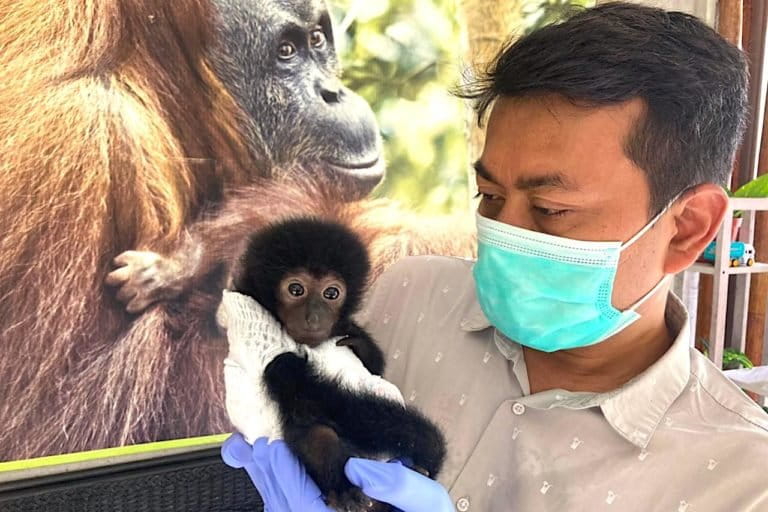- Gibbons are the singing acrobats of Sumatra’s forest canopy, and they are crucial for the health of the forest ecosystem due to their role as seed dispersers.
- But the illegal trade in gibbons for pets across Sumatra has to be taken as seriously as the trade in orangutans is.
- A new alliance of NGOs is advocating for better law enforcement, assessment of the illegal trade, and is campaigning against keeping gibbons as pets. They are also building a new gibbon rehabilitation center to appropriately rehabilitate confiscated gibbons.
- This article is a commentary and the views expressed are those of the author, not necessarily Mongabay.
When people think about apes in the connection with Sumatra, they will mainly picture the charismatic orangutans that are capturing international attention as well as conservation efforts. The attention for these two species (Sumatran and Tapanuli orangutans) is much needed as these great apes face the imminent risk of extinction and are listed as critically endangered due to habitat loss and the illegal trade.
But with the main public interest and conservation focus being on orangutans, other apes of Sumatra have received much less attention – like gibbons. There are three species of gibbon in Sumatra and all are classified as endangered. These are the largest of all gibbon species – the siamang (Symphalangus syndactylus), the lar or white-handed gibbon (Hylobates lar), and the agile gibbon (Hylobates agilis). The siamang occurs throughout Sumatra, while H. lar only inhabits forests in the north and H. agilis is in forests south of Lake Toba, with a convergence zone around Toba. Exact population numbers for all species are largely unknown.
Gibbons are classified as “small apes,” yet they certainly are no less special than “great apes.” They effortlessly brachiate (swing) through the forest canopy, and every species has a distinct song that ignites the jungle in the early morning hours. The first time I came to the Sumatran rainforest in May 2019 for an expedition, I was awakened at 6am every morning by the melodious duetting of agile gibbons.

Yet the most characteristic forest sound is the mesmerizing and unforgettable chorus of siamangs that breaks the temporary forest silence usually after the call of lar or agile gibbons, echoing throughout the forested mountain slopes. In areas that are forested, they are reasonably well represented; however, they are seriously threatened by habitat loss and the illegal trade of gibbon babies.
They are usually taken opportunistically during the deforestation process when they are trapped in a small forest fragment or an isolated tree, or during human-gibbon conflict. However, poachers also specifically target gibbons to snatch the baby when they know there is a buyer. For every gibbon baby that is traded there are usually two to four family members killed, in order to get the baby.
By law gibbons are protected wildlife in Indonesia and trading and owning them can be punished by up to five years in prison and a $5,900 fine. Even when people are arrested for trading orangutans, they rarely get maximum punishment and people that own orangutans rarely get brought to court as they willingly surrender the animal and therefore no legal action is taken. One can imagine how it is with gibbons.
For confiscated orangutans there have been intense rehabilitation efforts by the Sumatran Orangutan Conservation Program and affiliated partners for the last two decades with success in releasing them back to the wild. On the entire island of Sumatra there is only one gibbon rehabilitation center – Kalaweit in West Sumatra.

Yet the center is already at full capacity and cannot accommodate many more gibbons. There are likely hundreds of gibbons across Sumatra in need of rescue and the ones that do get confiscated by the wildlife authority (BKSDA) overwhelms the government as the BKSDA unfortunately has limited capacity and human resources with additionally little NGO support to provide sufficient support for the confiscated wildlife.
These gibbons are then usually released after being housed under inappropriate conditions without a proper rehabilitation protocols according to IUCN guidelines. Sometimes authorities have no other choice but to send gibbons to facilities such as zoos that also lack expertise and capacity for rehabilitation according to established international best practice guidelines.
There are also reports of gibbons being left behind during confiscations of orangutans as there is no proper facility in the northern part of Sumatra that can take care of gibbons. The tragedy is that the confiscated wildlife always falls victim, the trade is huge and incontrollable, and the authorities are in need of support and professional development (without having the necessary economic means to invest in this important aspect of fighting the trade, while NGOs with their own budget limitations focus on orangutans).

One of the main issues with gibbon rehabilitation is that release of ones that have been kept as a pet to the wild is very difficult. First of all, they need to be free of infectious diseases and in good overall health. Secondly, they need to be paired, which can be tricky as gibbon females are quite picky when it comes to choosing a life partner. Then, they need to be fed with food that they would find in the forest, for instance figs instead of papaya and banana, and they would need to be kept with as little human interaction as possible.
Finally, there needs to be a suitable habitat to release them into. In the case of gibbons that means protected old-growth forest with abundant fig trees, that is ideally not isolated and does not overlap with established gibbon territories in that area. Gibbons are extremely territorial, with territories ranging between 15-30 hectares, meaning that wild gibbons would kill released gibbons or the other way around if gibbons are released into a forest that is already occupied by wild ones.
Finding a forest that is protected and has either low gibbon densities or no gibbons present is very difficult if not impossible given that suitable forest would be already occupied. All this means that most confiscated gibbons will likely need lifelong sanctuary care, and if there are more gibbons coming in than are being released, the capacity for any rescue facility will be reached quickly, overwhelming authorities and NGOs alike.
To have a meaningful conservation impact on gibbons in the wild, the trade has to be curbed significantly, to stop gibbons from being victimized by the illegal wildlife trade in the first place. Currently, the extent of the gibbon trade in Sumatra is unknown, however given the number of confiscated gibbons across Sumatra and the general lack of focus on gibbons in Sumatra, it is likely that the trade is severe.
Perpetrators are rarely if ever punished for trading gibbons, hence it is a low risk crime. Further, the demand has to be tackled by increasing awareness about the illegality of keeping gibbons, and advocating for enforcing the law also on people that keep a gibbon as a pet. The trade in gibbons across Sumatra has to be taken as seriously as the trade in orangutans. They have been calling for help, yet so far, the gibbon trade has been pushed aside and largely ignored.
See related by the same writer: Rescuing Achilles: Southern pig-tailed macaques listed as endangered but still persecuted

There are some positive recent developments however, as a new alliance called Sumatran Rescue Alliance (SRA), initiated by the Orangutan Information Centre (OIC) and Centre for Orangutan Protection (COP), is now looking into stemming the gibbon trade through advocating for better enforcement of the law, assessing the trade and identifying traders, and raising public awareness through campaigning against keeping gibbons as pets.
SRA is now in the process of operationalizing a new gibbon rehabilitation center in North Sumatra in close collaboration with BKSDA North Sumatra, equipped to appropriately rehabilitate confiscated gibbons. This is a huge milestone for gibbons, and this is made possible because of a strong collaborative effort between the BKSDA North Sumatra and the NGOs fighting for gibbons.
Gibbons are the singing acrobats of the forest canopy and are crucial for the health of the forest ecosystem as seed dispersers. They have been delighting us with their songs and acrobatic shows, yet we have largely ignored the trade of gibbons in Sumatra and this needs to change. They need to be put in a similar spotlight as orangutans. Due to intense efforts over the last decades to combat the trafficking in orangutans and rehabilitate them, the situation has improved. Orangutan trafficking catches the attention of media, governments, and NGOs.
The trade in gibbons is cruel and inhumane and gibbons that have been victimized by the trade deserve proper rehabilitation, justice, and that this tragedy does not keep repeating itself over and over without the right action. I believe through dedication and supporting the overwhelmed government authorities through capacity building we can tackle the gibbon trade. The time is now, or the melodious calls will one day be replaced by silence.
Sinan Serhadli is an adviser on conservation and livelihood development programs across Southeast Asia for the People Resources and Conservation Foundation.
Related listening from Mongabay’s podcast: “Haunting gibbons’ songs could aid their conservation,” listen here: